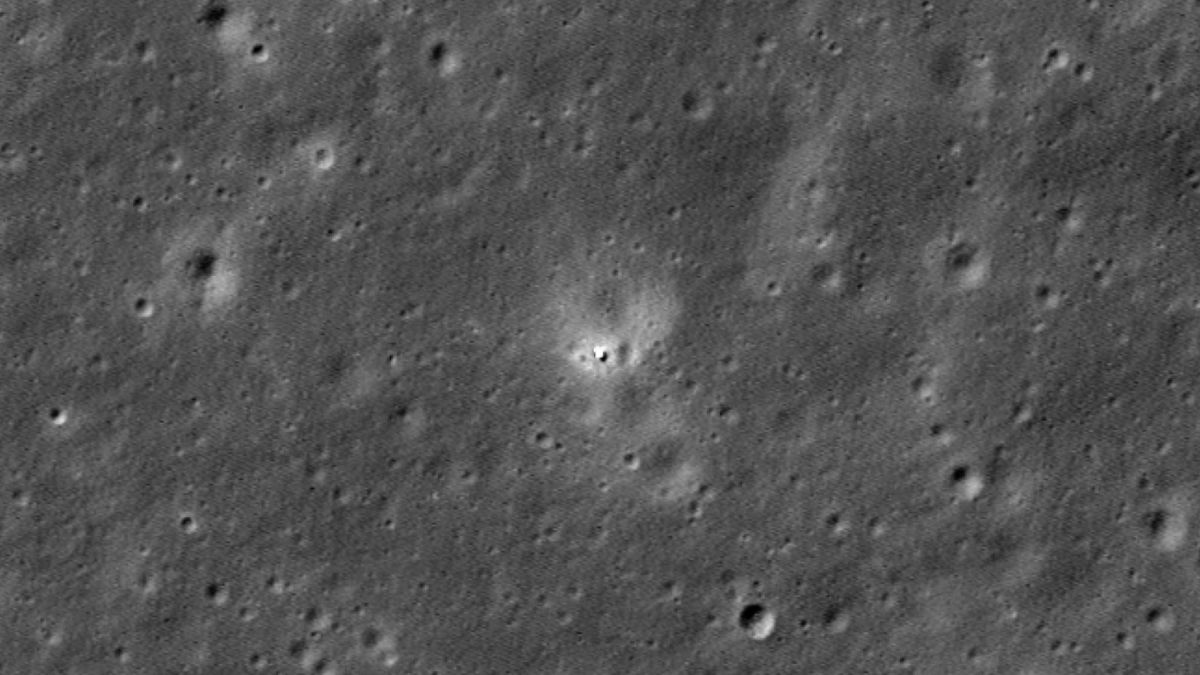NASA’s Lunar Reconnaissance Orbiter (LRO) has taken its first look at China’s Chang’e 6 spacecraft on the moon’s far side.
The Chang’e 6 lander is flanked by two craters similar in size to it and is on the edge of a much more subtle crater about 165 feet (50 meters) wide, reports Mark Robinson, the principal investigator of the sharp-eyed camera system onboard LRO.
LRO spotted Chang’e 6 within the Apollo basin on the far side of the moon on June 7, 2024. The lander is seen as a small cluster of bright pixels in the center of the image.
Rim shot
LRO imaged China’s Chang’e 6 sample-return spacecraft on the lunar far side five days after the latter’s landing.
The Lunar Reconnaissance Orbiter Camera (LROC) team computed the landing site coordinates as minus 41.6385 degrees north latitude and 206.0148 degrees east longitude, at minus 17,244 feet (minus 5,256 m) elevation relative to the average lunar surface, with an estimated horizontal accuracy of plus or minus 100 feet (30 m).
“The increased brightness of the terrain surrounding the lander is due to disturbance from the lander engine and is similar to the blast zone seen around other lunar landers,” the LROC team wrote in an image description.
Related: Watch China’s Chang’e 6 probe land on far side of the moon in dramatic video
LROC team members also posted an image of the same area taken on March 3, 2022, to show what it looked like before Chang’e 6’s landing and to highlight the presence of the spacecraft on the lunar surface.
The Chang’e 6 landing site is situated on a mare unit — a “sea” of cooled volcanic rock — at the southern edge of the Apollo basin.
Robinson and colleagues at Arizona State University note that basaltic lava erupted south of Chaffee S crater approximately 3.1 billion years ago and flowed downhill to the east, until it encountered a local topographic high, likely related to a fault.
“Several wrinkle ridges in this region have deformed and raised the mare surface,” the LROC image description states. “The landing site sits approximately halfway between two of these ridges. The lava flow also overlaps a slightly older flow (~3.3 Ga), visible further east, but the younger flow is distinctive because it has higher iron oxide (FeO) and titanium oxide (TiO2) abundances.” (“Ga” is scientist-speak for “billion years ago.”)
Homeward bound
Chang’e 6 launched from south China’s Hainan Province on May 3, with the goal of returning lunar samples from the far side of the moon to Earth for the first time ever.
After completing its collection of lunar samples, the probe’s ascender segment departed from the lunar surface with the precious cargo on June 3.
After reuniting with the Chang’e 6 mission orbiter and completing the lunar sample transfer, the returner segment continues to orbit the moon, awaiting the time to initiate its return journey back to Earth.
The mission’s return capsule is expected to land on our planet on or around June 25 with its cache of lunar collectibles. The capsule will parachute into a pre-picked landing zone at Siziwang Banner in north China’s Inner Mongolia Autonomous Region, wrapping up its 53-day space mission.











/https://tf-cmsv2-smithsonianmag-media.s3.amazonaws.com/filer_public/34/31/3431771d-41e2-4f97-aed2-c5f1df5295da/gettyimages-1441066266_web.jpg)








Discussion about this post